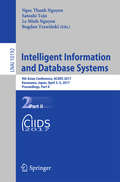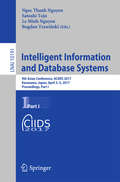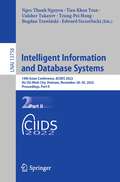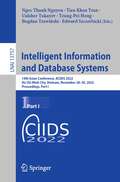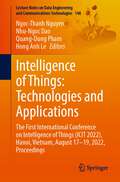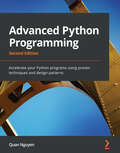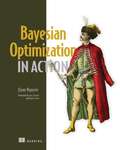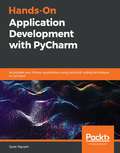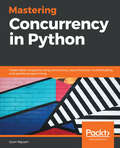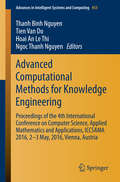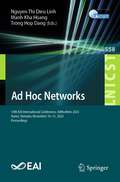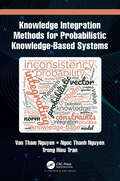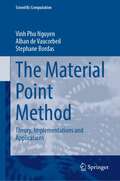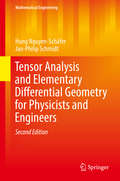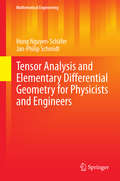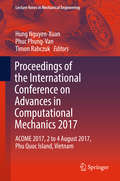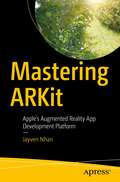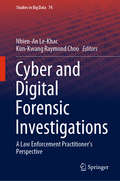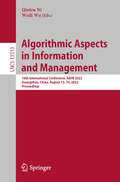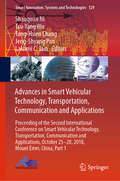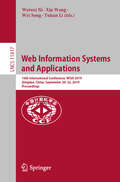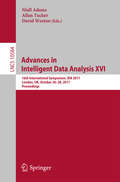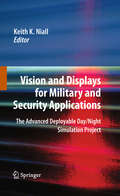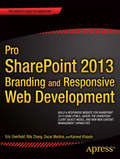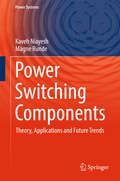- Table View
- List View
Intelligent Information and Database Systems
by Ngoc Thanh Nguyen Satoshi Tojo Le Minh Nguyen Bogdan TrawińskiIntelligent information and database systems are two closely related and we- established subfields of modern computer science. They focus on the integration of artificial intelligence and classic database technologies in order to create the class of next generation information systems. The major target of this new gene- tion of systems is to provide end-users with intelligent behavior: simple and/or advanced learning, problem solving, uncertain and certain reasoning, se- organization, cooperation, etc. Such intelligent abilities are implemented in classic information systems to make them autonomous and user oriented, in particular when advanced problems of multimedia information and knowledge discovery, access, retrieval and manipulation are to be solved in the context of large, distr- uted and heterogeneous environments. It means that intelligent knowledge-based information and database systems are used to solve basic problems of large coll- tions management, carry out knowledge discovery from large data collections, reason about information under uncertain conditions, support users in their for- lation of complex queries etc. Topics discussed in this volume include but are not limited to the foundations and principles of data, information, and knowledge models, methodologies for intelligent information and database systems analysis, design, implementation, validation, maintenance and evolution.
Intelligent Information and Database Systems
by Ngoc Thanh Nguyen Satoshi Tojo Le Minh Nguyen Bogdan TrawińskiIntelligent information and database systems are two closely related and we- established subfields of modern computer science. They focus on the integration of artificial intelligence and classic database technologies in order to create the class of next generation information systems. The major target of this new gene- tion of systems is to provide end-users with intelligent behavior: simple and/or advanced learning, problem solving, uncertain and certain reasoning, se- organization, cooperation, etc. Such intelligent abilities are implemented in classic information systems to make them autonomous and user oriented, in particular when advanced problems of multimedia information and knowledge discovery, access, retrieval and manipulation are to be solved in the context of large, distr- uted and heterogeneous environments. It means that intelligent knowledge-based information and database systems are used to solve basic problems of large coll- tions management, carry out knowledge discovery from large data collections, reason about information under uncertain conditions, support users in their for- lation of complex queries etc. Topics discussed in this volume include but are not limited to the foundations and principles of data, information, and knowledge models, methodologies for intelligent information and database systems analysis, design, implementation, validation, maintenance and evolution.
Intelligent Information and Database Systems: 14th Asian Conference, ACIIDS 2022, Ho Chi Minh City, Vietnam, November 28–30, 2022, Proceedings, Part II (Lecture Notes in Computer Science #13758)
by Ngoc Thanh Nguyen Tien Khoa Tran Ualsher Tukayev Tzung-Pei Hong Bogdan Trawiński Edward SzczerbickiThis book constitutes the refereed proceedings of the 14th Asian Conference on Intelligent Information and Database Systems, ACIIDS 2022, held Ho Chi Minh City, Vietnam in November 2022.The 113 full papers accepted for publication in these proceedings were carefully reviewed and selected from 406 submissions. The papers of the 2 volume-set are organized in the following topical sections: data mining and machine learning methods, advanced data mining techniques and applications, intelligent and contextual systems, natural language processing, network systems and applications, computational imaging and vision, decision support and control systems, and data modeling and processing for industry 4.0. The accepted and presented papers focus on new trends and challenges facing the intelligent information and database systems community.
Intelligent Information and Database Systems: 14th Asian Conference, ACIIDS 2022, Ho Chi Minh City, Vietnam, November 28–30, 2022, Proceedings, Part I (Lecture Notes in Computer Science #13757)
by Ngoc Thanh Nguyen Tien Khoa Tran Ualsher Tukayev Tzung-Pei Hong Bogdan Trawiński Edward SzczerbickiThis book constitutes the refereed proceedings of the 14th Asian Conference on Intelligent Information and Database Systems, ACIIDS 2022, held Ho Chi Minh City, Vietnam in November 2022.The 113 full papers accepted for publication in these proceedings were carefully reviewed and selected from 406 submissions. The papers of the 2 volume-set are organized in the following topical sections: data mining and machine learning methods, advanced data mining techniques and applications, intelligent and contextual systems, natural language processing, network systems and applications, computational imaging and vision, decision support and control systems, and data modeling and processing for industry 4.0. The accepted and presented papers focus on new trends and challenges facing the intelligent information and database systems community.
Intelligence of Things: The First International Conference on Intelligence of Things (ICIot 2022), Hanoi, Vietnam, August 17–19, 2022, Proceedings (Lecture Notes on Data Engineering and Communications Technologies #148)
by Ngoc-Thanh Nguyen Nhu-Ngoc Dao Quang-Dung Pham Hong Anh LeThis book constitutes the refereed proceedings of the First Conference on Intelligence of Things (ICIoT 2022), held in Hanoi, Vietnam, in August 2022. A total of 40 full papers in this book have been rigorously peer-reviewed and selected from over 100 submissions. The papers focused on the intelligence of things (AIoT) studies are organized in the following parts: theoretical intelligence analyses, intelligence services and applications, and intelligence service experiments. This book provides interested students and engineers with comprehensive and cutting-edge studies in the fields.
Advanced Python Programming: Accelerate your Python programs using proven techniques and design patterns, 2nd Edition
by Quan NguyenWrite fast, robust, and highly reusable applications using Python's internal optimization, state-of-the-art performance-benchmarking tools, and cutting-edge librariesKey FeaturesBenchmark, profile, and accelerate Python programs using optimization toolsScale applications to multiple processors with concurrent programmingMake applications robust and reusable using effective design patternsBook DescriptionPython's powerful capabilities for implementing robust and efficient programs make it one of the most sought-after programming languages.In this book, you'll explore the tools that allow you to improve performance and take your Python programs to the next level.This book starts by examining the built-in as well as external libraries that streamline tasks in the development cycle, such as benchmarking, profiling, and optimizing. You'll then get to grips with using specialized tools such as dedicated libraries and compilers to increase your performance at number-crunching tasks, including training machine learning models.The book covers concurrency, a major solution to making programs more efficient and scalable, and various concurrent programming techniques such as multithreading, multiprocessing, and asynchronous programming.You'll also understand the common problems that cause undesirable behavior in concurrent programs.Finally, you'll work with a wide range of design patterns, including creational, structural, and behavioral patterns that enable you to tackle complex design and architecture challenges, making your programs more robust and maintainable.By the end of the book, you'll be exposed to a wide range of advanced functionalities in Python and be equipped with the practical knowledge needed to apply them to your use cases.What you will learnWrite efficient numerical code with NumPy, pandas, and XarrayUse Cython and Numba to achieve native performanceFind bottlenecks in your Python code using profilersOptimize your machine learning models with JAXImplement multithreaded, multiprocessing, and asynchronous programsSolve common problems in concurrent programming, such as deadlocksTackle architecture challenges with design patternsWho this book is forThis book is for intermediate to experienced Python programmers who are looking to scale up their applications in a systematic and robust manner. Programmers from a range of backgrounds will find this book useful, including software engineers, scientific programmers, and software architects.
Bayesian Optimization in Action (In Action)
by Quan NguyenBayesian optimization helps pinpoint the best configuration for your machine learning models with speed and accuracy. Put its advanced techniques into practice with this hands-on guide.In Bayesian Optimization in Action you will learn how to: Train Gaussian processes on both sparse and large data sets Combine Gaussian processes with deep neural networks to make them flexible and expressive Find the most successful strategies for hyperparameter tuning Navigate a search space and identify high-performing regions Apply Bayesian optimization to cost-constrained, multi-objective, and preference optimization Implement Bayesian optimization with PyTorch, GPyTorch, and BoTorch Bayesian Optimization in Action shows you how to optimize hyperparameter tuning, A/B testing, and other aspects of the machine learning process by applying cutting-edge Bayesian techniques. Using clear language, illustrations, and concrete examples, this book proves that Bayesian optimization doesn&’t have to be difficult! You&’ll get in-depth insights into how Bayesian optimization works and learn how to implement it with cutting-edge Python libraries. The book&’s easy-to-reuse code samples let you hit the ground running by plugging them straight into your own projects. Forewords by Luis Serrano and David Sweet. About the technology In machine learning, optimization is about achieving the best predictions—shortest delivery routes, perfect price points, most accurate recommendations—in the fewest number of steps. Bayesian optimization uses the mathematics of probability to fine-tune ML functions, algorithms, and hyperparameters efficiently when traditional methods are too slow or expensive. About the book Bayesian Optimization in Action teaches you how to create efficient machine learning processes using a Bayesian approach. In it, you&’ll explore practical techniques for training large datasets, hyperparameter tuning, and navigating complex search spaces. This interesting book includes engaging illustrations and fun examples like perfecting coffee sweetness, predicting weather, and even debunking psychic claims. You&’ll learn how to navigate multi-objective scenarios, account for decision costs, and tackle pairwise comparisons. What's inside Gaussian processes for sparse and large datasets Strategies for hyperparameter tuning Identify high-performing regions Examples in PyTorch, GPyTorch, and BoTorch About the reader For machine learning practitioners who are confident in math and statistics. About the author Quan Nguyen is a research assistant at Washington University in St. Louis. He writes for the Python Software Foundation and has authored several books on Python programming. Table of Contents 1 Introduction to Bayesian optimization 2 Gaussian processes as distributions over functions 3 Customizing a Gaussian process with the mean and covariance functions 4 Refining the best result with improvement-based policies 5 Exploring the search space with bandit-style policies 6 Leveraging information theory with entropy-based policies 7 Maximizing throughput with batch optimization 8 Satisfying extra constraints with constrained optimization 9 Balancing utility and cost with multifidelity optimization 10 Learning from pairwise comparisons with preference optimization 11 Optimizing multiple objectives at the same time 12 Scaling Gaussian processes to large datasets 13 Combining Gaussian processes with neural networks
Hands-On Application Development with PyCharm: Accelerate your Python applications using practical coding techniques in PyCharm
by Quan NguyenA definitive guide to PyCharm to help you build business-oriented Python applications ranging from modern web development to data science Key Features Learn basic to advanced PyCharm concepts to improve efficiency of your Python projects Work through practical examples that focus on efficient application development with PyCharm Explore advanced features in PyCharm such as code automation, version control, and GUI debugging Book Description JetBrain's PyCharm is the most popular Integrated Development Environment (IDE) used by the Python community thanks to its numerous features that facilitate faster, more accurate, and more productive programming practices. However, the abundance of options and customizations can make PyCharm seem quite intimidating. Hands-on Application Development with PyCharm starts with PyCharm's installation and configuration process, and systematically takes you through a number of its powerful features that can greatly improve your productivity. You'll explore code automation, version control, graphical debugging/testing, management of virtual environments, and much more. Finally, you'll delve into specific PyCharm features that support web development and data science, two of the fastest growing applications in Python programming. These include the integration of the Django framework as well as the extensive support for IPython and Jupyter Notebook. By the end of this PyCharm book, you will have gained extensive knowledge of the tool and be able to implement its features and make the most of its support for your projects. What you will learn Explore PyCharm functionalities and what makes it stand out from other Python IDEs Set up, configure, and customize your Python projects in PyCharm Understand how PyCharm integrates with Django for web development Discover PyCharm's capabilities in database management and data visualization Perform code automation, GUI testing, and version control in PyCharm Integrate interactive Python tools such as Jupyter Notebooks for building virtual environments Who this book is for If you're a beginner or an expert Python user looking to improve your productivity using one of the best Python IDEs, this book is for you. Basic knowledge of Python programming language is expected.
Mastering Concurrency in Python: Create faster programs using concurrency, asynchronous, multithreading, and parallel programming
by Quan NguyenImmerse yourself in the world of Python concurrency and tackle the most complex concurrent programming problemsKey FeaturesExplore the core syntaxes, language features and modern patterns of concurrency in PythonUnderstand how to use concurrency to keep data consistent and applications responsiveUtilize application scaffolding to design highly-scalable programs Book DescriptionPython is one of the most popular programming languages, with numerous libraries and frameworks that facilitate high-performance computing. Concurrency and parallelism in Python are essential when it comes to multiprocessing and multithreading; they behave differently, but their common aim is to reduce the execution time. This book serves as a comprehensive introduction to various advanced concepts in concurrent engineering and programming.Mastering Concurrency in Python starts by introducing the concepts and principles in concurrency, right from Amdahl's Law to multithreading programming, followed by elucidating multiprocessing programming, web scraping, and asynchronous I/O, together with common problems that engineers and programmers face in concurrent programming. Next, the book covers a number of advanced concepts in Python concurrency and how they interact with the Python ecosystem, including the Global Interpreter Lock (GIL). Finally, you'll learn how to solve real-world concurrency problems through examples.By the end of the book, you will have gained extensive theoretical knowledge of concurrency and the ways in which concurrency is supported by the Python languageWhat you will learnExplore the concepts of concurrency in programmingExplore the core syntax and features that enable concurrency in PythonUnderstand the correct way to implement concurrencyAbstract methods to keep the data consistent in your programAnalyze problems commonly faced in concurrent programmingUse application scaffolding to design highly-scalable programsWho this book is forThis book is for developers who wish to build high-performance applications and learn about signle-core, multicore programming or distributed concurrency. Some experience with Python programming language is assumed.
Advanced Computational Methods for Knowledge Engineering: Proceedings of the 4th International Conference on Computer Science, Applied Mathematics and Applications, ICCSAMA 2016, 2-3 May, 2016, Vienna, Austria (Advances in Intelligent Systems and Computing #453)
by Thanh Binh Nguyen Tien Van Do Hoai An Le Thi Ngoc Thanh NguyenThis proceedings consists of 20 papers which have been selected and invited from the submissions to the 4th International Conference on Computer Science, Applied Mathematics and Applications (ICCSAMA 2016) held on 2-3 May, 2016 in Laxenburg, Austria. The conference is organized into 5 sessions: Advanced Optimization Methods and Their Applications, Models for ICT applications, Topics on discrete mathematics, Data Analytic Methods and Applications and Feature Extractio, respectively. All chapters in the book discuss theoretical and practical issues connected with computational methods and optimization methods for knowledge engineering. The editors hope that this volume can be useful for graduate and Ph.D. students and researchers in Applied Sciences, Computer Science and Applied Mathematics.
Ad Hoc Networks: 14th EAI International Conference, AdHocNets 2023, Hanoi, Vietnam, November 10-11, 2023, Proceedings (Lecture Notes of the Institute for Computer Sciences, Social Informatics and Telecommunications Engineering #558)
by Nguyen Thi Dieu Linh Manh Kha Hoang Trong Hop DangThis book constitutes the refereed post-conference proceedings of the 14th EAI International Conference on Ad Hoc Networks, AdHocNets 2023, held in Hanoi, Vietnam, during November 10-11, 2023.The 15 full papers were carefully reviewed and selected from 39 submissions. They were organized in topical sections as follows: intelligent integrated systems; wireless communications; and network solutions.
Knowledge Integration Methods for Probabilistic Knowledge-based Systems
by Van Tham Nguyen Ngoc Thanh Nguyen Trong Hieu TranKnowledge-based systems and solving knowledge integrating problems have seen a great surge of research activity in recent years. Knowledge Integration Methods provides a wide snapshot of building knowledge-based systems, inconsistency measures, methods for handling consistency, and methods for integrating knowledge bases. The book also provides the mathematical background to solving problems of restoring consistency and integrating probabilistic knowledge bases in the integrating process. The research results presented in the book can be applied in decision support systems, semantic web systems, multimedia information retrieval systems, medical imaging systems, cooperative information systems, and more. This text will be useful for computer science graduates and PhD students, in addition to researchers and readers working on knowledge management and ontology interpretation.
The Material Point Method: Theory, Implementations and Applications (Scientific Computation)
by Vinh Phu Nguyen Alban de Vaucorbeil Stephane BordasThis book provides an introduction to the fundamental theory, practical implementation, and core and emerging applications of the material point method (MPM) and its variants. The MPM combines the advantages of both finite element analysis (FEM) and meshless/meshfree methods (MMs) by representing the material by a set of particles overlaid on a background mesh that serves as a computational scratchpad.The book shows how MPM allows a robust, accurate, and efficient simulation of a wide variety of material behaviors without requiring overly complex implementations. MPM and its variants have been shown to be successful in simulating a large number of high deformation and complicated engineering problems such as densification of foam, sea ice dynamics, landslides, and energetic device explosions, to name a few, and have recently found applications in the movie industry. It is hoped that this comprehensive exposition on MPM variants and their applications will not only provide an opportunity to re-examine previous contributions, but also to re-organize them in a coherent fashion and in anticipation of new advances.Sample algorithms for the solutions of benchmark problems are provided online so that researchers and graduate students can modify these algorithms and develop their own solution algorithms for specific problems. The goal of this book is to provide students and researchers with a theoretical and practical knowledge of the material point method to analyze engineering problems, and it may help initiate and promote further in-depth studies on the subjects discussed.
Tensor Analysis and Elementary Differential Geometry for Physicists and Engineers (Mathematical Engineering #21)
by Hung Nguyen-Schäfer Jan-Philip SchmidtThis book presents tensors and differential geometry in a comprehensive and approachable manner, providing a bridge from the place where physics and engineering mathematics end, and the place where tensor analysis begins. Among the topics examined are tensor analysis, elementary differential geometry of moving surfaces, and k-differential forms. The book includes numerous examples with solutions and concrete calculations, which guide readers through these complex topics step by step. Mindful of the practical needs of engineers and physicists, book favors simplicity over a more rigorous, formal approach. The book shows readers how to work with tensors and differential geometry and how to apply them to modeling the physical and engineering world.The authors provide chapter-length treatment of topics at the intersection of advanced mathematics, and physics and engineering: • General Basis and Bra-Ket Notation• Tensor Analysis• Elementary Differential Geometry• Differential Forms• Applications of Tensors and Differential Geometry• Tensors and Bra-Ket Notation in Quantum MechanicsThe text reviews methods and applications in computational fluid dynamics; continuum mechanics; electrodynamics in special relativity; cosmology in the Minkowski four-dimensional space time; and relativistic and non-relativistic quantum mechanics.Tensor Analysis and Elementary Differential Geometry for Physicists and Engineers benefits research scientists and practicing engineers in a variety of fields, who use tensor analysis and differential geometry in the context of applied physics, and electrical and mechanical engineering. It will also interest graduate students in applied physics and engineering.
Tensor Analysis and Elementary Differential Geometry for Physicists and Engineers (Mathematical Engineering)
by Hung Nguyen-Schäfer Jan-Philip SchmidtTensors and methods of differential geometry are very useful mathematical tools in many fields of modern physics and computational engineering including relativity physics, electrodynamics, computational fluid dynamics (CFD), continuum mechanics, aero and vibroacoustics and cybernetics.This book comprehensively presents topics, such as bra-ket notation, tensor analysis and elementary differential geometry of a moving surface. Moreover, authors intentionally abstain from giving mathematically rigorous definitions and derivations that are however dealt with as precisely as possible. The reader is provided with hands-on calculations and worked-out examples at which he will learn how to handle the bra-ket notation, tensors and differential geometry and to use them in the physical and engineering world. The target audience primarily comprises graduate students in physics and engineering, research scientists and practicing engineers.
Proceedings of the International Conference on Advances in Computational Mechanics 2017: Acome 2017, 2 To 4 August 2017, Phu Quoc Island, Vietnam (Lecture Notes In Mechanical Engineering)
by Hung Nguyen-Xuan Phuc Phung-Van Timon RabczukThis book provides an overview of state-of-the-art methods in computational engineering for modeling and simulation.This proceedings volume includes a selection of refereed papers presented at the International Conference on Advances in Computational Mechanics (ACOME) 2017, which took place on Phu Quoc Island, Vietnam on August 2-4, 2017.The contributions highlight recent advances in and innovative applications of computational mechanics. Subjects covered include: biological systems; damage, fracture and failure; flow problems; multiscale multiphysics problems; composites and hybrid structures; optimization and inverse problems; lightweight structures; computational mechatronics; computational dynamics; numerical methods; and high-performance computing.The book is intended for academics, including graduate students and experienced researchers interested in state-of-the-art computational methods for solving challenging problems in engineering.
Mastering ARKit: Apple’s Augmented Reality App Development Platform
by Jayven NhanEmbark on a journey to build an augmented reality world. This book puts theory into practical application by building unique augmented reality apps specific to each chapter’s topic.You’ll learn to engineer successful, well-designed, and comprehensive augmented reality applications for Apple devices. First, uncover the foundation of augmented reality on Apple platforms. Understand the building blocks and inner workings of the technologies that power augmented reality. Then, learn about building AR apps using ARKit, SceneKit, SpriteKit, RealityKit, and RealityComposer. You’ll study augmented reality app business models, designs, and content for the ultimate user experience. Plus, you’ll cover the theories and practicalities of ARKit APIs such as surface detection, working with world maps, body motion capture, face tracking, object scanning and detecting, people occlusion, and more. Chapter by chapter, this book helps you to become an advanced augmented reality engineer. By the end of the book, you’ll have the necessary mental models and tools to engineer delightful experiences in Apple’s augmented reality platforms. What You'll LearnBuild AR apps with SceneKit, SpriteKit, RealityKit, and RealityComposerUnderstand the business models that support augmented realityIncorporate surface detection, computer vision, and body motion capture in your appsWho This Book Is ForiOS developers who want to expand their knowledge of ARKit. They should have a solid foundation in the Swift programming language and understand the basics of navigating Xcode.
Cyber and Digital Forensic Investigations: A Law Enforcement Practitioner’s Perspective (Studies in Big Data #74)
by Nhien-An Le-Khac Kim-Kwang Raymond ChooUnderstanding the latest capabilities in the cyber threat landscape as well as the cyber forensic challenges and approaches is the best way users and organizations can prepare for potential negative events. Adopting an experiential learning approach, this book describes how cyber forensics researchers, educators and practitioners can keep pace with technological advances, and acquire the essential knowledge and skills, ranging from IoT forensics, malware analysis, and CCTV and cloud forensics to network forensics and financial investigations. Given the growing importance of incident response and cyber forensics in our digitalized society, this book will be of interest and relevance to researchers, educators and practitioners in the field, as well as students wanting to learn about cyber forensics.
Algorithmic Aspects in Information and Management: 16th International Conference, AAIM 2022, Guangzhou, China, August 13–14, 2022, Proceedings (Lecture Notes in Computer Science #13513)
by Qiufen Ni Weili WuThis book constitutes the proceedings of the 16th International Conference on Algorithmic Aspects in Information and Management, AAIM 2022, which was held online during August 13-14, 2022. The conference was originally planned to take place in Guangzhou, China, but changed to a virtual event due to the COVID-19 pandemic.The 41 regular papers included in this book were carefully reviewed and selected from 59 submissions.
Advances in Smart Vehicular Technology, Transportation, Communication and Applications: Proceeding of the Second International Conference on Smart Vehicular Technology, Transportation, Communication and Applications, October 25-28, 2018 Mount Emei, China, Part 1 (Smart Innovation, Systems and Technologies #129)
by Shaoquan Ni Tsu-Yang Wu Tang-Hsien Chang Jeng-Shyang Pan Lakhmi C. JainThis book highlights papers presented at the Second International Conference on Smart Vehicular Technology, Transportation, Communication and Applications (VTCA 2018), which was held at Mount Emei, Sichuan Province, China from 25 to 28 October 2018. The conference was co-sponsored by Springer, Southwest Jiaotong University, Fujian University of Technology, Chang’an University, Shandong University of Science and Technology, Fujian Provincial Key Lab of Big Data Mining and Applications, and the National Demonstration Center for Experimental Electronic Information and Electrical Technology Education (Fujian University of Technology). The conference was intended as an international forum for researchers and professionals engaged in all areas of smart vehicular technology, vehicular transportation, vehicular communication, and applications.
Web Information Systems and Applications: 16th International Conference, WISA 2019, Qingdao, China, September 20-22, 2019, Proceedings (Lecture Notes in Computer Science #11817)
by Weiwei Ni Xin Wang Wei Song Yukun LiThis book constitutes the proceedings of the 16th International Conference on Web Information Systems and Applications, WISA 2019, held in Qingdao, China, in September 2019. The 39 revised full papers and 33 short papers presented were carefully reviewed and selected from 154 submissions. The papers are grouped in topical sections on machine learning and data mining, cloud computing and big data, information retrieval, natural language processing, data privacy and security, knowledge graphs and social networks, blockchain, query processing, and recommendations.
Advances in Intelligent Data Analysis XVI: 16th International Symposium, IDA 2017, London, UK, October 26–28, 2017, Proceedings (Lecture Notes in Computer Science #10584)
by Niall Adams, Allan Tucker and David WestonThis book constitutes the conference proceedings of the 16th International Symposium on Intelligent Data Analysis, which was held in October 2017 in London, UK.The 28 full papers presented in this book were carefully reviewed and selected from 66 submissions. The traditional focus of the IDA symposium series is on end-to-end intelligent support for data analysis. IDA solicits papers on all aspects of intelligent data analysis, including papers on intelligent support for modelling and analyzing data from complex, dynamical systems.
Vision and Displays for Military and Security Applications
by Keith K. NiallThe book discusses advances in projection technologies used for simulation in military and security applications. More specifically, the subject of this book is using high-resolution projection display technology for simulating night vision device conditions while increasing the distance that objects can be simulated under simulated daylight conditions. Topics covered include: advances in high-resolution projection, advances in image generation, advances in geographic modelling or photogrammetric technologies, night vision goggle human factors research, night vision goggle training techniques. The book will have special features including graphs and systems operational architectural diagrams specific to these domains. The main benefit the reader will gain from this book is that it will present leading edge methods for conducting human factors research for night vision device research, while also presenting leading edge technologies used design and apply visual displays for current simulations.
Pro SharePoint 2013 Branding and Responsive Web Development
by Benjamin Niaulin Chris Beckett Eric Overfield Kanwal Khipple Oscar Medina Rita ZhangPro SharePoint 2013 Branding and Responsive Web Development is the definitive reference on the technologies, tools, and techniques needed for building responsive websites and applications with SharePoint 2013. The book focuses on solutions that provide the best browser experience for the myriad of devices, browsers, and screen orientations and resolutions. Web technology has changed considerably in the past few years. Microsoft has embraced the new generation of open standards represented by HTML5 and JavaScript, and these changes are represented in a fundamental shift in how SharePoint 2013 supports web content management and publishing. Authors Eric Overfield, Oscar Medina, Kanwal Khipple, and Rita Zhang join forces to dive into the new features and capabilities provided by SharePoint 2013 and combine them with the latest techniques in responsive web design and development to demonstrate how to build modern and progressive websites and applications. Pro SharePoint 2013 Branding and Responsive Web Development covers the following technologies: SharePoint 2013 Server Edition Office 365 SharePoint Online Expression Blend 2013 Napa Tools for Office and SharePoint Development Visual Studio 2012 HTML5 and CSS3 JavaScript, JQuery, JQuery UI, Modernizr, and the Bootstrap Framework SharePoint 2013 Client Object Model
Power Switching Components
by Kaveh Niayesh Magne RundeThis book focuses on the theory and application of power switching components in power networks. More specifically, it discusses current interruption theory, applied stresses to switching components in power networks and appropriate methods to test their different functionalities. It reviews the basic working principles of current technologies and summarizes the upcoming technological advances within the field of power switching devices. Taking an educational approach to the subject, this book is useful for graduate courses on high voltage equipment and power device technology within the electric power engineering discipline. Furthermore, inclusion of numerous worked examples, exercises and easily digestible descriptions of complex physical phenomena in switching devices make this an invaluable self-learning resource for engineers.
